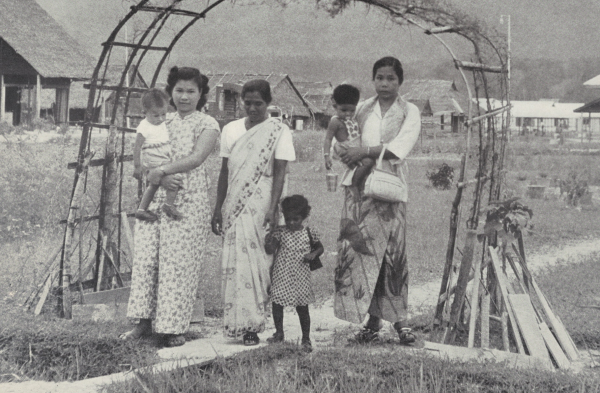This is an old revision of the document!
Table of Contents
British: Pasca Pendudukan Jepun (1940-1957)
Ringkasan
Selepas Pendudukan Jepun dan kembalinya pentadbiran British, kadar kematian bayi menurun secara mendadak. Faktor-faktornya ialah peningkatan mutu kesihatan awam dan sanitasi, pengawalan wabak malaria, penambahan inokulasi bayi, pengawasan bidan-bidan (ordinan 1954), penjagaan perubatan dan khidmat nasihat oleh klinik kesihatan ibu dan anak: “After World War II: Infant mortality rate dropped radically. Factors: improvements in public health & sanitation, malaria control, increased inoculation of infants, supervision of midwives (ordinance 1954), medical care & advice by maternal and child health clinics.”
(Sumber: Lenore Manderson, International Journal of Health Services, Vol. 12, No. 4 (1982), pp. 597-616 (20 pages): |"BOTTLE FEEDING AND IDEOLOGY IN COLONIAL MALAYA: THE PRODUCTION OF CHANGE").

“Figure 10. Unknown photographer, Cover of New Village in Malaya (Set of 12 Plates) (London: COI, 1953). LOT 7301 (G), Prints and Photographs Reading Room, Library of Congress, Washington, DC.” (Taylor, J. E. (2022). History of Photography, 46(2–3), 164–183: |"Humanising the Squatter: Photography in the Service of Resettlement in Emergency-era Malaya", m.s.178).
Kronologi
1940-an: Galakan Penyusuan di Akhbar
- 1940-03-28 - end of 1941: Nurse Elizabeth @ 'Problems of Babies and Young Children': Letters from readers show diverse infant feeding practices: BF exclusive, BF+bottle, bottle-only (maternal ill-health). Disagreed on intervals, every baby needs to be considered individually (ST 1941-06-26, supplement, p.ii). BF strongly encouraged. Complementary & supplements discouraged, only necessary with dried / evaporated, not sweetened condensed milk: '[breast milk contains] plenty of all the vitamnis which baby requires, and he would be able to assimilate them far more easily if he receives them through your milk than he would if he were to take the preparation itself (ST 1941-06-26, supplement p.ii). Advised to re-establish lactation, with guides to establish & sustain lactation. Column resumed 1947: 'Mothers will realize, more than ever, the enormous importance of breast feeding their babies … if the mother's own diet contains all the essentials she need have no fear, for her baby will thrive and develop perfectly' (ST 1947-06-17, p.5).
1940-an: Hubungkait Susu Botol dengan Gejala Cirit Birit
Correlation of bottle feeding and jangkitan cirit birit pada bayinfantile gastroenteritis established by Levi and Alexander. Only since this time, doctors and governments became concerned with dangers of bottle feeding.
1941: Pendudukan Jepun
Supply of manufactured goods disrupted (Japanese occupation) - women had to breastfeed. British Medical Officers associated with improved infant mortality rate.
1945: Pengembalian Pentadbiran British
Reinstatement of British administration: Infant welfare & maternal health care resumed with medical & public health services. Limited cow's milk supply through government agencies, so majority infants breastfed. However, according to an official correspondence immediately after reinstatement of British Administration: Chief Nutrition Adviser, 1948-11 (10, folio 8): “70,000-80,000 tons of dried milk would be required … for the expectant and nursing mothers, babies and children. Unfortunately the Nutrition Council, because of the cost of even this quantity of milk, feels this amount will have to be reduced still further. THe least additional quantity we can ask for is 10,000 tons … The council recommends that this extra milk should be powdered, skimmed milk since this is probably more easily and cheaply obtained… We believe the importation of extra milk is necessary to prevent disease and unrest in the country.” Regular supply resumed: Advertising returned.
1946: Penurunan Kadar Kematian Bayi
Infant mortality: 92/1000: gov: 'improvement in maternal nutrition .. reduced consumption of overmiled rice, greater use of other foods due to food shortages, increase in breast feeding due to condensed milk shortage. Meanwhile in Singapore, only Indians breastfeed, bottle feeding serious problem among wealthy Chinese & poor. Due to ads, sweetened condensed milk used most, many could not afford sufficient quantity.
1950-an: Iklan Untuk Khalayak Umum
Advertising start for the masses.
1954: Pemberian Susu Percuma
Infant mortality decreased steadily: Malaya: 83/1000, Singapore: 56.10/1000. 38,614 pounds of free milk (also hemanitic drugs, vitamins, cod liver oil) distributed free. Classes conducted at clinics. Medical Department Report include illustration of a clinic nurse with bottles, teats and a tin of Lactogen. Also reports second major cause of infant death was gastroenteritis associated wit bottle feeding and weaning. However Gov introduced free milk program, supply dried full cream milk and baby food through infant welfare clinics, particularly to poor Malays north & east coast. Milk + cocoa in schools. Continued until mid-1970s (already prime cause).
1956: Peluasan Pesat Perkhidmatan Kesihatan Ibu dan Anak
Maternal and child health centers expanded dramatically. 72, 518 sub-health. Distribution of free powdered milk only if anemic/malnutrition. Gov: 'breast feeding is advised for all infants but when there is contraindication to breast feeding and when babies are older then powdered milk is given to those mothers who cannot afford to buy it'.
Akhir 1950-an: Iklan di Akhbar Melayu
Daily ads in Utusan Melayu: Cow and Gate, Lactogen, Klim, Every Day, Milkmaid. Also tonics, worm powders, chocolates, supplements, cough mixtures. In English press: Carnation Milk, Dutch Baby, Ostermilk (Glaxo) infant milks, compete with Cow and Gate & Nestle (Lactogen, Nestogen (low-fat infant food), Eledon buttermilk (premature underdeveloped babies), Gluco-B supplement, Nespray (older babies & general use), Nestum (cereal for weaning), Babex dehydrated fruit & vege (for weaning) ( e.g. ST 1959-07-07, p.4). New milk brands: Blue Cross, Baby Stork. New weaning fods: Farex, Barlova, Lacova. Pictures of Asian babies and testimonies from Asian mothers used. Ostermilk: 'especially suitable for babies in Malaysia' (ST 1957-07-16, p.7). Morinaga: 'good for infants, because it is just like mothers' own milk, and is especially suitable for Asian babies' (Berita Harian, 1963-09-16, p.15).
